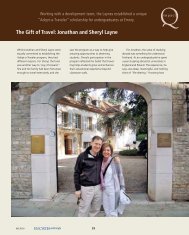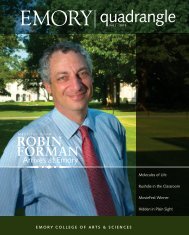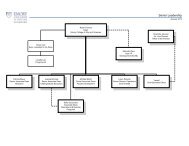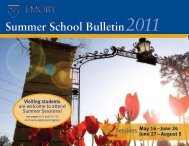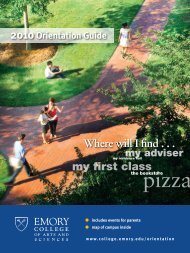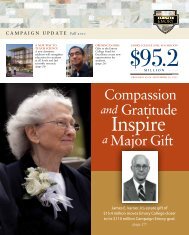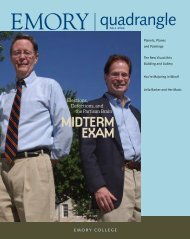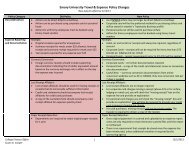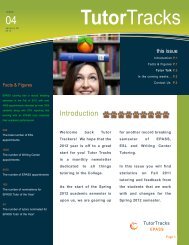quadrangle - Emory College - Emory University
quadrangle - Emory College - Emory University
quadrangle - Emory College - Emory University
You also want an ePaper? Increase the reach of your titles
YUMPU automatically turns print PDFs into web optimized ePapers that Google loves.
Ward says she approached the space byconsidering its uses as a student lounge,study area, and place to network.When it was time for Randy Fullerton, a lecturer inthe theater studies department, to choose artwork for<strong>Emory</strong> <strong>College</strong>’s newest building, Psychology and InterdisciplinarySciences (PAIS), two factors weighed heavily on him.One, the facility was designed to foster collaboration amongpsychologists and other scholars at the <strong>University</strong> (see QuadrangleFall 2007, p. 14: college.emory.edu/alumni/quad/archives/Q07F/Q07F.pdf.). Two, the economic downturn left him with only a fractionof the original budget to work with.That’s when it dawned on him. What if the artwork itself contributedto interdisciplinary approaches and connections amongfaculty and students?“Because there’s such a vast array of talent on the <strong>Emory</strong>campus,” says Fullerton, also general manager of the Center forCreativity & Arts, “the psychology faculty thought it wouldbe a great idea to showcase the work of creative individuals indepartments and disciplines throughout <strong>Emory</strong>.”IfThese WallsCould Talkby Hal JacobsTo find a dynamic piece that would adorn the high-ceilingedlobby in the north end of the building, he commissioned SaraWard, a scenic artist and scenic designer in theater studies/Theater <strong>Emory</strong>.Ward says she approached the space by considering its usesas a student lounge, study area, and place to network. Thisled her to think about ideas of “connection” and “absorptionof knowledge.” The result is a symphony of textures and layers,with a streak of green and faded cream orange suggestingmotion. The piece infuses the open space with a sense of energyand purpose, even the sense of theatricality one might expectfrom a set designer.Fullerton turned to faculty in biology and chemistry for othersources of inspiration.Biologist Leslie Real, Asa G. Candler Professor, learned hisway around a darkroom at the age of twelve. In graduate schoolhe was able to pursue his interest in drawing and painting despitethe concerns of faculty mentors whowanted him to focus solely on science. Hesees photography as “just another way ofexploring the natural world.” His prints inthe PAIS building reflect his attention tothe color, texture and form of landscapes.(Some of his work can be seen at larealphotography.com.)Above: David Goldsmith. Below: Sara Ward.Opposite page: Stephan Hamann. Left: Leslie Real.Chemist David Goldsmith receivedthe <strong>College</strong>’s 2009 Distinguished FacultyEmeritus Award; he also received space on severalwalls for his striking photographs. From 1963 to2002, he carried on an extensive research programin organic chemistry while also keeping up anactive interest in photography. His prints have beenshown in exhibitions at the galleries of the AtlantaPhotographers Group, the Alliance Française andthe Unitarian church; he’s also shared his talents inphotography-related courses at <strong>Emory</strong>’s Center forLifelong Learning.Psychology is represented on the walls ofthe PAIS building by associate professor StephanHamann. More than 30,000 years ago, cavepainters adorned their walls with drawings ofwild animals. Hamann prefers to work withimages from research and neuroimaging (themodern equivalent of stalking wild creatures?).While his research and teaching focus on thestudy of memory and emotion using neuroimagingand other approaches, turning his researchinto art is a fairly recent phenomenon for him.For the PAIS building he created severalpieces: one takes a “Warholesque” look at brainscans, and another involves a photomosaic composedof about 160 small images culled from theweb pages of faculty and graduate students—and many hours of Photoshopping. The imageis adapted from one of those old phrenology busts (sketching areas on the skull from which to read personality, intellect, etc.).Hamann has received “very gratifying” feedback from his colleagues, he says; his next opus is yet to be determined.In addition to the building’s artwork, there are other design elements in the building to stimulate the senses. The wood-veneeredpanels on the second floor are an example from quarter-sawn eucalyptus logs (hence the striking pattern in the grain). Throughout thebuilding, white gypsum panels give the walls a fluid, dynamic quality.If these walls could talk, what would they say? Fullerton believes it might be something like, “Enjoy. Now go out and dosomething creative.”8 spring 2010spring 2010 9
1977 Robert A. Paul arrives at <strong>Emory</strong>1979 Woodruff gift . . . helps establish Anthro dept1982 publishes The Tibetan Symbolic WorldAs TimeByInGoesillustration by Bruno Mallartmore than three decades at <strong>Emory</strong>,Dean Robert A. Paul has worn plentyof hats: professor, chair, dean, patron of the arts. Ofthe programs new and old that he has had a handin creating, nurturing or directing, here are a fewreports from the front.Interdisciplinary StudiesThe Institute of the Liberal Arts “began as an experiment in thought,” says director and Samuel C. Dobbs Professor Kevin Corrigan.“Thought about literature, about religion, theology, American studies….” Founded in 1952, the ILA is “one of the oldest institutes of ourkind in the country.”The ILA’s undergraduate program Interdisciplinary Studies in Society and Culture (IDS) grew out of a Liberal Studies major in the1990s, according to senior lecturer and director of undergraduate studies Peter Wakefield, at a time when “interest in interdisciplinarywork, and a lot of innovative research along those lines,” began bubbling through the academy. It has stayed true to its flexiblenature since, with undergraduate majors broadening to include American Studies and Medieval-Renaissance Studies. Together theyoffer students a buffet of seventy courses on a wide variety of topics, from“Culture & Power in East Asia” to “Science and the Nature of Evidence” to“Baseball and American Culture.” A new minor in Science, Culture & Societywill be joined this year by another in Sustainability.But variety is only part of the idea here. Linking disciplines, setting themconversing, is the raison d’etre. Corrigan admits that interdisciplinarity canbe “a buzzword” nowadays, “but it’s very hard to bring about in reality. I thinkthis is a place where it actually does happen. We have the ILA Colloquium, forinstance, run by Angelika Bammer, which brings together faculty and studentsfrom across the <strong>College</strong> and helps to link <strong>Emory</strong>’s divisions and schools as well.“It’s all about sharing research,” Corrigan continues, “and it’s focused uponconversation. Because interdisciplinarity functions not only in terms of methodsand practices but also in terms of real conversation—where things don’t always goexactly your way, do they? There’s a give and take that’s essential to the process.”Wakefield adds that ILA faculty “constantly grapple with how we defineourselves and our emphases. We need to allow innovation in topics of research,so we’re not concretized. This is partially reflected in some of our new concentrations,for instance Public Scholarship or Medical Humanities. We welcomefaculty from other departments who can come in and participate. But in fiveor ten years those researchers might be elsewhere, and we need the flexibilityto define another research focus. One thing we’re working on is plugging ourgraduate students into courses where they could teach their current researchtopics, introducing undergraduates to cutting-edge research. We’re trying tointegrate across various levels.”Their writing lab is another aspect of IDS that Wakefield feels sets it apart.“Across all our 200-level courses we’ve introduced this model. Students fromevery section gather for a common writing lab, which this semester for the firsttime is peer-taught—we take our best writers from the previous semester andtrain them to teach the labs. We treat writing as a vital tool of understanding,and we want to give very structured instruction in that.”Corrigan gives some credit for the institute’s success to Dean Paul. “Since hearrived in 1977 [as an ILA associate professor] he has been a motive force all theway through. He was director for two separate terms, and as dean he’s envisionedthe ILA as a kind of green space in the middle of the university. It’s a creativechamber, if you will, where other programs such as comparative literature, AfricanAmerican studies, and film studies have either taken a temporary sojourn or haveactually been generated out of the ILA. It’s a place where the faculty constantly getscharged to reinvent itself.”Wakefield agrees. “The general atmosphere of support,” he says, “is justunprecedented at the institutions where I’ve worked. And I attend a lot of internationalconferences about interdisciplinary studies where we’re really a model,a leader in the field.”“We have a host of living relationships with almost every department andprogram in the <strong>College</strong>,” Corrigan says. “We give students a sheer variety ofchoices, but also the structure and academic rigor they need.“The ILA is, and should be, a place of possibilities—as many as thereare students.”My recollections of Bobby Paul combine teacher and dean.I came to <strong>Emory</strong> in 1987 as a scared but excited graduate studentand took his “Symbolic Anthropology” class in my very firstsemester. I had studied anthropology as part of my master’s program,but I’d never had a class like this one—difficult, but stimulatingand a lot of fun. Bobby is a masterful teacher. He taughtwithout notes but seemed to remember every detail of everyreading. His syllabus was full of texts that continue to influencemy thinking, and he always drew out each student’s best ideas.The most memorable class occurred on the Tuesday beforeThanksgiving. Bobby walked into the room, abandoned the syllabusand began a symbolic analysis of Thanksgiving traditions. Hediscussed the turkey as a sacrificial animal, the tradition of eatingourselves into a stupor as a kind of ritual trance, the formalgiving of thanks as spiritual incantation. By the end of class wewere all laughing, brainstorming, and offering our own symbolicinterpretations. And we all walked away with an entirely newunderstanding of the holiday—one that helped us recognize thatAmericans have customs connecting us to cultures from acrosscenturies and around the globe.Although I now have a new relationship with Bobby—he is acolleague, boss and creative partner on projects that affect theentire <strong>College</strong>—I continue to consider him first as a valued teacherand mentor.—Kim Loudermilk, senior associate dean of <strong>Emory</strong> <strong>College</strong>10 spring 2010spring 2010 11
16 spring 2010 spring 2010 17Barbara Washington as Mambo MaryShelley in Theater <strong>Emory</strong>’s Frankenstein
ookmarksFeatured TitleHow Wars Endby Dan ReiterPrinceton <strong>University</strong> Press, 2009wars fought to the finish of unconditional surrender and warsfought to more limited outcomes, wars fought in a variety ofregions including North America, Europe, and East Asia, andwars fought across nearly a century of time, from the 1860s tothe 1950s.Analysis of these wars permits exploration of a number ofspecific war-termination puzzles, beyond those enumerated atthe beginning of this chapter. Some of these puzzles include:How did the Soviet Union react to the December 1939 battlefielddisasters it faced against Finland during the Winter War? . . .How did President Lincoln react to the apparent collapseof support for the Union war effort in summer 1864, whencontinuation for the war seemed to ensure his electoral defeatthat November? . . .Why did Germany, as it was defeating Russia in the East,reject Allied peace overtures in the winter of 1917-18 andinstead choose to continue the war by renewing its offensivein the West?. . . The fog of war and the patience of leaders also sometimessever the connection between battle outcomes andwar-termination behavior. Additionally, the cases indicate thecurious insignificance of domestic politics in war-terminationdecision making, in contrast to existing theoretical and empiricalresearch on how democracies fight wars. There is little evidencethat democratic leaders are especially casualty-sensitive,and hence are more likely than other kinds of leaders to considerconcessions as casualties mount.Dan Reiter is professor and chair of political science,with research interests in world politics and internationalrelations. He joined the <strong>Emory</strong> faculty in 1995.Excerpt:Love is like war; easy to begin but very hard to stop.—H.L. MenckenHow, when, and why do belligerents end wars? Why dosome losing belligerents, such as the United States in the earlymonths of the Korean War, the Confederacy in the twilight ofthe American Civil War, Britain during the dark night of May1940, and the United States in the first months of World WarII, refuse to consider negotiating to end their wars on acceptableterms and instead fight on in pursuit of victory? Why dosome winning belligerents, such as the Soviet Union in thelatter months of its 1939-40 and 1941-44 wars against Finland,elect to stop fighting and accept limited gains rather than fightonward in pursuit of the total defeat of the adversary?. . . We know relatively little about how wars end, in contrastto the mountain ranges of ideas and scholarship we haveabout how wars start. Indeed, there has been something of anaversion to the study of war termination over the past severaldecades. The total nature of World War II seemed a denial ofthe political significance of war termination since in an eraof total war the belligerents fight with all their resources untilone side is utterly crushed. This neglect of war terminationpersisted through the Cold War, when most assumed thatany major war would quickly escalate to nuclear attacks andArmageddon, making the topic of war termination a grim joke.Interest in war termination received little boost by the VietnamWar, as the bad taste left by that conflict encouraged thinkingabout stopping wars from happening rather than stopping warsonce they have started. . . .Any understanding of war must be grounded in the empirical.How have wars actually ended? How well does actualbehavior square with our theoretical expectations?I provide some of the first empirical evidence that directlyassesses how belligerents try to end wars, and whether and howwar-termination behavior is shaped by information and commitmentdynamics. Specifically, a belligerent who loses battlesis supposed to downgrade its estimates of his own militarypower, and be more willing to offer concessions. Is this whatactually happens? Does war-termination diplomacy tend to followbattlefield outcomes in this manner? If not, are there conditionsunder which this pattern is observed, and conditionsunder which it is not? . . .This book examines war-termination decisions anddynamics in an array of wars, including the Korean War, theAllies in World War II, Japan during World War II, Germanyduring World War I, the Union and Confederacy during theAmerican Civil War, and Finland and the Soviet Union duringboth the Winter War and the Continuation War. These casesare neither a complete sample of all belligerents nor are theya random sample. However, they do represent a wide rangeof historical/political/military contexts since they includelong wars and short wars, both civil and international wars,wars between equal powers and between unequal powers,Recent <strong>Emory</strong> <strong>College</strong> Faculty BooksPatrick Allitt. The Conservatives: Ideas and PersonalitiesThroughout American History.William Beik. A Social and Cultural History of EarlyModern France.Peter Bing. The Scroll and the Marble.Rudolph Byrd, Beverly Guy-Sheftal and JohnettaB. Cole. I Am Your Sister.Joe Crespino and Matt Lassiter. The Myth of SouthernExceptionalism.Richard Doner. The Politics of Uneven Development.David Eltis and Frank Lewis, eds. Human Capital andInstitutions: A Long Run View.Mikhail Epstein. After the Future.----. Sola Amore (Only by Love).Lisa Dilman, trans. Op Oloop (Juan Filloy).Frances Smith Foster. ‘Til Death or Distance Do Us Part.----. Beverly Guy-Sheftall and Stanlie James. Still Brave.Roberto Fransozi. Quantitative Narrative Analysis.Jennifer Gandhi. Political Institutions Under Dictatorship.Rosemarie Garland-Thomson. Staring: How We Look.Andra Gillespie. Whose Black Politics? Cases in Post-RacialBlack Leadership.Sander Gilman. Diseases and Diagnoses: The Second Ageof Biology.Jonathan Goldberg. The Seeds of Things.Benjamin Hary. Translating Religion.Lynne Huffer. Mad for Foucault: Rethinking the Foundationsof Queer Theory.Harvey Klehr, John Earl Haynes and Alexander Vassiliev.Spies: The Rise and Fall of the KGB in America.Gary Laderman. Sacred Matters.Frank Lechner. Globalization: The Making of World Society.Scott Lilienfeld. 50 Great Myths of Popular Psychology.Walter Melion. Scripture for the Eyes.----. The Meditative Art.James Melton and Jonathan Strom, eds. Pietismin Germany and North America, 1680–1820.James Melton. La Aparicion del Publico durante laIlustracion Europea.Matthew Morris. Melusine de Couldrette.Mary Odem and Elaine Lacy, eds. Latino Immigration andthe Transformation of the U.S. South.Michael Peletz. Gender Pluralism: Southeast Asia Since EarlyModern Times.Jose Quiroga. Law of Desire.Mark Risjord. Nursing Knowledge: Science, Practice, andPhilosophy.Don Seeman. One People, One Blood: Ethiopian-Israelis andthe Return to Judaism.Sharon Strocchia. Nuns and Nunneries in RenaissanceFlorence.James Taulbee. International Crime and Punishment:A Guide to the Issues.Alessandro Veneziani, Luca Formaggia and AlfioQuarteroni. Cardiovascular Mathematics.Donald Verene. Speculative Philosophy.---- and T.I. Bayer, eds. Giambattista Vico: Keys to theNew Science.Vanessa Siddle Walker. Hello Professor: A Black Principaland Professional Leadership in the Segregated South.18 spring 2010spring 2010 19
Rosemarie Garland-ThomsonNotable Faculty AchievementsRecent Faculty GrantsLeft to right: photo by Billy Howard;painting Shayla by Doug AuldIt’s not every day that someone links your name with an Islamic filmmaker, an animal rights activist, a Columbian urbanplanner, a maverick economist, the Dalai Lama, the guy who introduced the CD-ROM, and leaders of innovative companieslike SunEdison and Dust-to-Digital.Juliette Apkarian, associate professor of Russian and EastAsian Languages and Cultures, won the Marion V. CreekmoreAward for Internationalization.Edna Bay, professor in the Institute of Liberal Arts,Paul Kelleher, assistant professor of English, DonaldLivingston, professor of philosophy, and Tracy Morkin,lecturer in chemistry, won <strong>Emory</strong>’s Crystal Apple Award forexcellence in teaching.Matthew Bernstein, professor and chair of film studies,had his book Screening a Lynching selected as an “outstandingacademic title” by Publisher’s Choice Reviews.Peggy Barlett, anthropology, Judith Robertson, anthropology—GeorgiaDepartment of AgricultureKyle Beardsley, political science—Folks Bernadotte AcademySimon Blakey, chemistry, David Borthwick, math& computer science, Huw Davies, chemistry, EldadHaber, math & computer science, Craig Hill, chemistry,Djamaladdin Musaev, chemistry, Eric Weeks, physics—National Science FoundationPatricia Brennan, psychology—National Alliance forResearch on SchizophreniaBut Rosemarie Garland-Thomson, professor of women’sstudies, found herself in that company when the magazineUtne Reader named her one of “50 Visionaries Who Are ChangingYour World.” Her book Staring: How We Look has garnered a gooddeal of attention lately. But this was recognition of another kind.“It was something very different, very unexpected,” Garland-Thomson said recently. “It was pretty interesting to see whothey selected, and what kind of pattern that made—to trace notso much the liberal politics all through it, which is perhaps to beexpected in Utne, but the recognition of social justice work. I wasreally pleased that they understood the book as having a social justicecomponent.”She has written or edited four other volumes and publisheddozens of scholarly articles, but this book seems particularly tohave hit a cultural nerve. Library Journal recently listed Staring asthe fourth-bestselling book in philosophy. It was also the subjectof a prominent feature in the Chronicle of Higher Education, andGarland-Thomson has been kept busy with media requests andtalks at universities and conferences. An exhibit of paintings, drawingsand photographs inspired by the book (and some included init) ran at Davidson <strong>College</strong> for two months last fall.“They took some of the ideas of the book, and a little of thelanguage and art, and augmented it with related work from theirown collection and others, structuring what I would call thematicvisual essays on the book’s topics. It was wonderful. One of theartists featured in the book is Doug Auld, who’s done a series ofpaintings called State of Grace, portraits of burn survivors, that areextremely powerful.”Utne notes in its citation of Garland-Thomson’s work that“Disabled people attract stares, and this social critic posits that theattention sometimes transforms a would-be stigma into empowerment.”Staring can be unsettling, Garland-Thomson points out, notonly for the “starees” (a word she coined for those on the receivingend of the gaze), but also for the starers, who may be struggling tomake sense of what they see and struggling, too, with the socialban on staring as childlike and rude.Garland-Thomson turns the experience around to show howstarees might manage the moment, control it, push it toward understanding—andthus become subjects rather than simply objects ofthe interaction.“What I tried to do in Staring was to present an analysis ofvisual culture for both a scholarly and general audience—academicresearch that would also be public scholarship. I think the culturalwork of language is an important aspect of both. I try to find languagethat is vivid and accurate, and that doesn’t reproduce thekinds of biases and stereotypes that you’re working against.“There’s a lot of interesting vocabulary from disability studies,for example, that helps vivify our understanding of who we are aspeople. In the literature there often appears the word ‘sighted’ toidentify people who are not blind, or ‘hearing’ to identify someonewho communicates that way instead of by sign language. My colleagueAlice Dreger in her work on conjoined twins uses the word‘singleton’ to talk about the rest of us. Bringing forward a positionthat we regard as normal and unremarkable, and especially givingit a name, has the effect of making other positions less invisible.It deepens the range and meaning of human diversity. Thatlanguage-building project is part of all my books.”A short Staring video is at youtube.com/emoryuniversity#p/search/2/jALsDVW63wo.Lisa Dillman, senior lecturer in Spanish, has been nominatedfor a 2010 Best Translated Fiction award for her translation ofOp Oloop by Argentinian writer Juan Filloy.Andra Gillespie, assistant professor of political science,received a Ford Foundation Diversity Fellowship and was honoredby the urban politics section of the American PoliticalScience Association for strong early career scholarship andfuture promise.Earl Lewis, Provost and Asa Griggs Candler Professor ofHistory and African American Studies, was appointed toa three-year term on the National Advisory Committee onInstitutional Quality and Integrity.Raman Parimala, Asa G. Candler Professor of Mathematics,was invited to be a plenary speaker at the 2010 InternationalCongress of Mathematics in Hyderabad.Caroline Schaumann, associate professor of Germanstudies, received a Humboldt Research Fellowship forExperienced Researchers.Yanna Yannakakis, assistant professor of history, won theHoward Francis Cline Memorial Prize for the best book publishedin 2007 or 2008 about indigenous Latin Americans forThe Art of Being In-Between.Irene Browne, sociology, Mary Odem, history—<strong>Emory</strong>Institute for Developing NationsRon Calabrese, biology, Victor Corces, biology, StellaLourenco, psychology, David Lynn, chemistry, EdwardRamos, biology, James Taylor, biology, Elaine Walker,psychology—National Institutes of HealthHuw Davies, chemistry—Buffalo Biolabs, Toyota ResearchInstitute of North AmericaGerman studies department—Max Kade FoundationThomas Gillespie, environmental studies—<strong>University</strong> ofWisconsin, Morris Animal FoundationCraig Hill, chemistry—TDA Research, Office of Naval ResearchGary Laderman, religion—Ford FoundationSara Markowitz, economics—State <strong>University</strong> of NewYork, AlbanyDjamaladdin Musaev, chemistry—Office of Naval Research20 spring 2010spring 2010 21
Memories and ReasonsRecent Faculty Grants (continued)Thomas Remington, political science—National Councilfor Eurasian and East European ResearchMichael Rich, political science—Annie E. Casey FoundationClaire Sterk, sociology—Andrew W. Mellon FoundationJames Taylor, biology—Pennsylvania State <strong>University</strong>Regina Werum, sociology—Spencer FoundationJohn Zupko, philosophy—Fordham <strong>University</strong>Student HonorsSurabhi Agrawal is the 2010–2011 Robert T. Jones Fellow andEmily Cumbie-Drake, Steven Dry, Walter Ecton andPhilip May received the 2010–2011 Robert T. Jones Scholarshipfor study at the <strong>University</strong> of St. Andrews in Scotland.Monique Dorsainvil won the 2009 Lucius Lamar McMullanAward, given to a graduating senior who exhibits outstanding citizenship,exceptional leadership and potential for service to his orher community, the nation and the world.Nicolai Lundy received <strong>Emory</strong>’s highest student honor, theMarion Luther Brittain Award, presented to a graduate whohas demonstrated exemplary service to the <strong>University</strong> and thegreater community.On December 3, seven principals in the Campaign for the <strong>College</strong>met in Candler Library to discuss what alumni remember, somethings they might not know, and why they give.The group included Matthew Bernstein, professor of filmstudies and chair of the My <strong>Emory</strong> campaign for faculty and staff;Tash Elwyn 93C, chair of the <strong>Emory</strong> <strong>College</strong> Alumni Boarddevelopment committee; Kim Loudermilk 97 PhD, seniorassociate dean of <strong>Emory</strong> <strong>College</strong>; Josh Newton, senior associatevice president for arts and sciences development; Robert A.Paul, dean of <strong>Emory</strong> <strong>College</strong>; Wendell Reilly 80C, chair of theCampaign for the <strong>College</strong>; and Chandra Stephens-Albright85C, national chair of the <strong>Emory</strong> Annual Fund Board. Quadrangleeditor David Raney 99PhD moderated. A video excerpt is availableat youtube.com/watch?v=Q90VnZ_okn4.Quadrangle Thanks to all of you for taking a few minutes to chat. I’ll start by asking not so much what you’ve given to theCampaign, but what you get from it. What excites you about it? Why do you do it?Sasha Munro was awarded the <strong>Emory</strong> Alumni Board LeadershipScholarship recognizing “students whose actions, beliefs and passionshave improved their community.”TEI think what first motivated me to begin giving to <strong>Emory</strong> was selfish, in a positive way. Both my brother and I receivedcourtesy scholarships. Having had the tremendous privilege of attending <strong>Emory</strong> free of tuition, I vowed as I graduatedthat I would repay that debt to <strong>Emory</strong>, however many years that took. So my wife and I—she’s also an <strong>Emory</strong>grad—have been very consistent donors throughout the years.KLI’m not an alum of <strong>Emory</strong> <strong>College</strong>, so I don’t have the same kind of connection you had, but because I work withthe <strong>College</strong> budget, and with <strong>College</strong> students, I see what a real difference it makes when people give. When I talkto students who receive financial aid and might not have been able to come here without that help, that to me isthe payback.MBHaving taught at <strong>Emory</strong> for 20 years now, I feel it’s a terrific community to be part of. I’ve always felt that <strong>Emory</strong><strong>College</strong> is a place where you can initiate ideas and programs, and develop them. My wife and I began giving to artsevents—Friends of Theater <strong>Emory</strong>, Friends of the Library—and now with the push to support financial aid, that’sa principle we very much support.WRI also went to <strong>Emory</strong> <strong>College</strong>, and it was a very important part of my life. It is, as Matthew says, a community, onethat I feel privileged to be part of. One of the distinctions of <strong>Emory</strong> <strong>College</strong> I think is the caliber of the faculty, andthat strong tradition of teaching continues. <strong>Emory</strong> Advantage is another of Mary’s and my philosophical reasons forsupporting the <strong>College</strong> because we believe that access to an education of this caliber is central to the mission here.We want to do everything we can do to help preserve that commitment.Quadrangle Are there other priorities in the Campaign that particularly interest you, that strike a chord?CSI have to go back to what Wendell and Tash said. I’m a <strong>College</strong> graduate too, and my first year was the year ofWoodruff’s gift—The Gift—and it makes me proud to know that kids who might not have had the opportunity cancome to <strong>Emory</strong> now, and don’t have to settle for anything less. That’s the main thing for me, to attract the caliberof student that can do well here.22 spring 2010spring 2010 23
Left to right: Matthew Bernstein, Tash Elwyn, Kim Loudermilk,Chandra Stephens-AlbrightTEMB I have conversations with alumni who perhaps took a coursewith me, or in my department. And their fondness for thefaculty, their memories, their warmth, is really overwhelming.This is one of the reasons one goes into teaching—you canmeet students who years later remember the impact that youor your program had on them. So that’s been delightful. Nota surprise exactly, because I wouldn’t be an educator if I didn’tfeel education could have that impact. But it’s very gratifying.JNOne of the things I find interesting is that while there is asense of place at <strong>Emory</strong>, it’s so much less about place thanit is about people. The quad could disappear tomorrow, butthe heart of <strong>Emory</strong> would still exist. Because what peopletalk about are their professors, their friends whose weddingsthey’re still attending, and their children’s weddings. Tonightin New York City there’s a gathering of sixty-one alumni.It’s not an <strong>Emory</strong> event; they’re bringing themselves together.And there’s an alum right now who anonymously sponsorsthe annual staff luncheon in honor of a former secretary whowas very nice to him during his time here. So it’s about thepeople, not just the place.I think the Campaign reflects that. It doesn’t have as much brick and mortar as you might expect in a capitalcampaign. There’s a Psychology Building, and we’d like to see a theater building happen as well. But most of theCampaign is about faculty and student resources. That’s the heart and soul of it. That might surprise some people.Quadrangle Have there been other surprises along the way? Any misconceptions you’ve encountered about the <strong>College</strong>or the Campaign?WRJNKLJNWell, one perception could be that <strong>Emory</strong> <strong>College</strong> has a lot of money, so why campaign at all? Indeed, <strong>Emory</strong> <strong>University</strong>has resources that rank among the top in the country. But <strong>Emory</strong> <strong>College</strong> would be near the bottom of its peer group interms of resources. There’s a benefit, of course, to being part of a large university—you get the best of both worlds, theliberal arts experience amid the larger <strong>University</strong>. But the downside is that the <strong>College</strong> sometimes gets blurred with thatlarger identity.If I could sit down with every alum, it would be to tell that story. <strong>Emory</strong> <strong>University</strong>’s endowment is not the<strong>College</strong>’s endowment, which would rank at the bottom of our peers. We need to continue to build on ourendowment and to strengthen the opportunities our students can have.Here’s a misconception I hear a lot: “My $25 doesn’t make any difference.” In fact it does, and not only in terms ofparticipation. If everyone in the <strong>College</strong> or <strong>University</strong>, or in a graduating class, gave $25, that would be a lot ofmoney. We should help people understand that those small amounts make a huge difference.Of just under 50,000 alums, just over 500 people give more than a thousand dollars. So it’s not as if the bigdonors are carrying all the weight. There are very few donors at those levels. We need gifts at all levels, andevery gift does matter.RPStudent support is important, of course, and the other side of that is to support faculty. But if you want to hire a facultymember, very few people are in a position to make that kind of gift. That’s an area, it seems to me, where classesor other collectives could ally to help a department, to create an alumni chair. Groups can do what a single individualmight not be able to.When I started going out and meeting with alums, I was struck by how appreciative people are. Originally itwas a surprise, now it no longer is—parents, alums, students all have very upbeat, exciting things to say. I think wemust be doing something right, in creating such an important experience for families across the country. Andhelping translate that appreciation into support is very gratifying. We’re an unusually generous society as a whole.People may not be fond of taxes, of being told what to support, but they do like to contribute to things. And ifthat choice is based on “What meant a lot to me that I can help someone else experience?” it’s hard to think whatwould outstrip investing in a college like <strong>Emory</strong>.Quadrangle What do alums talk about appreciating?RPCSWRJNRPI think the total social experience, the clubs and activities, the friends they still have, those sorts of memories combinedwith the academics. I sometimes hear the question “Do we need residential colleges—can’t you just put allthis information up on the Web and be done with it?” And it’s clear that so much of what is learned is becauseof the social environment. With other students, friends, caring professors, a whole supportive community. It’s anessential part; you can’t unplug that.For me, it was the education. I wanted to major in chemistry. I got into Yale, and Harvard, and Brown but I couldn’t affordto go any of those places without working. <strong>Emory</strong> was in that peer group for me, and to be able to go here and have thefull academic experience—that was amazing. And I wanted to give back, and the minute I could give $1,000 I did.There are people in my <strong>Emory</strong> experience who I credit with, first of all, helping me finish. There was a pointwhen I was convinced I was not destined to get a college degree. And a teacher saw something in me thatI didn’t even see in myself. So I would urge any student in the <strong>College</strong> to approach and develop a formal relationshipwith a professor, or two or three. Faculty are very accessible. It’s been an <strong>Emory</strong> hallmark since the beginning.And to me that made all the difference.That’s a good reminder that we’re not askingpeople for their charity but for their investment.Your institution should be there for you, whetherit’s social support or job opportunities or networking.Being a part of the <strong>Emory</strong> community shouldbe about connecting to others, in good times andbad. We can continue to support each other.It is an investment. Some payoffs are in value weproduce in the world, but there’s also the value ofyour diploma on the wall. When you put that on aresume or on someone’s desk, it’s worth a lot morenow than it ever was. It was worth a good dealthen, and even more now. We’ve worked very hardto make this one of the premier credentials thatpeople can have, and that’s thanks to the generosityand hard work of a great many people.Left to right: David Raney, Wendell Reilly, Josh Newton24 spring 2010spring 2010 25
Distinguished Alumni and Faculty Emeriti AwardsIn September, on Homecoming Friday, four distinguished alumni and facultyreceived the highest honor presented by <strong>Emory</strong> <strong>College</strong> of Arts & Sciences.Distinguished Alumni Award: Sharon Semmens 80C 80GSharon Semmens graduated magna cum laude with a BA in political science,then earned her masters in political science. The department of political sciencerecognized Semmens as its outstanding undergraduate with the Elliott LevitasAward, and the Barkley Forum awarded her the Warren Aiken OutstandingAlumni Contribution Award.Semmens, a member of the <strong>Emory</strong> Alumni Board, has been an active supporterof a more diverse, open-minded environment for everyone. To this end,in 2005 she cofounded <strong>Emory</strong> Gay and Lesbian Alumni, the <strong>Emory</strong> AlumniAssociation’s interest group for lesbian/gay/bisexual/transgender alumni, andcontinues to serve as its co-chair. She has also served as board chair and interimexecutive director for Georgia Equality. In 2008, the vice provost’s Office ofCommunity and Diversity appointed her to its advisory board.Distinguished Alumni Award: Beth Volin 75CBeth Volin (left) graduated from <strong>Emory</strong> with a BA in art history, and earneda doctor of medicine degree from Northwestern <strong>University</strong>. She is currently thedirector of general pediatrics and associate chair of the pediatrics departmentat Rush Children’s Hospital in Chicago. In 1997 she founded the Kids-SHIP(Kids Shelter Health Improvement Project) program, which has served morethan 9,000 homeless children during the past decade at Rush-Presbyterian-St.Luke’s Medical Center.The Kids-SHIP program provides homeless children and adolescents inChicago-area shelters with comprehensive health care. It also increases awarenessof and sensitivity to homeless patients among pediatric residents and medicalstudents. Volin serves as the director of the Rush Reach Out and Read Program,promoting early literacy by giving children books in pediatric exam rooms.Volin’s husband, Gary Wainer 75C, and daughter, Allison Wainer 08C(right), are <strong>Emory</strong> alumni, and both Volin and Wainer are members of the<strong>Emory</strong> <strong>College</strong> Alumni Board.Young Alumni Service Award: Lesley Pories 03CLesley Pories (far left) has been heavily involved with volunteer servicethroughout her career at the <strong>College</strong> and after. While at <strong>Emory</strong> she internedat the Carter Center, as well as in the European Parliament in Brussels. Shewas also a member of co-ed service fraternity Alpha Phi Omega, whereshe worked with nonprofit agencies such as Open Hand and Habitat forHumanity. She graduated with a double major in English and internationalstudies. At Commencement, she was recognized with the DistinguishedSenior Service Award.After graduation Pories volunteered for the Peace Corps in Uzbekistanfrom 2003 to 2005, teaching English to high school students and workingtoward women’s empowerment. When she returned, she spent three yearsworking with the international development community, serving as programcoordinator for the World Resources Institute in Washington, D.C., amongother positions.Pories has also served on the board of directors for the Returned PeaceCorps Volunteers of Washington, D.C., and worked with service organizationGreater DC Cares. Her most recent endeavor took her to Hubli, India,where she completed a one-year Deshpande Foundation Global ExchangePrograms fellowship with the Water Literacy Foundation, a local water conservationorganization.Distinguished Faculty Emeritus Award: David GoldsmithFrom 1963 to 2002, David Goldsmith (left) served the chemistry department andhelped it grow. He won the Williams Award, <strong>Emory</strong>’s highest teaching award, in1982 and 1991. Goldsmith was the director of graduate studies and chaired thedepartment for seven years.He actively participated in the planning of new and renovated chemistrybuildings at the <strong>University</strong>, including Atwood and Emerson Halls. He also helpedplan the Mathematics and Science Center. Goldsmith has represented <strong>Emory</strong>as a visiting scholar at the Université Louis Pasteur of Strasbourg, the Ecole deChimie of Mulhouse, and the Université Joseph Fourier of Grenoble, France.While teaching classes and running a research program in organic chemistry,Goldsmith found time to develop an interest in photography. After retiringhe continued to teach, offering a photography course at <strong>Emory</strong>’s Center forLifelong Learning. His prints have been exhibited at galleries around Atlanta.—Lindsey Bomnin 12C26 spring 2010spring 201027
“We believe strongly in giving back. Who cares what you give—the point is to do it. . . .It’s easy to write a check. The challenging part is figuring out how you’re going toput your money to good.”Robert SpanoConductor, composer, pianist, and Atlanta Symphony Orchestradirector Robert Spano 09H began a three-year appointment asThe Ammerman ScholarshipT H E I M P A C T O F F A M I L Y<strong>University</strong> Distinguished Artist-in-Residence this spring. A multipleGrammy Award winner, Maestro Spano gave public lectures, led concertsand collaborated on <strong>College</strong> courses. “I eagerly anticipate exploringWe all know the calls. They usually come at dinnertime,asking us to donate to a cause or a candidate. Many of usscreen them now; we make it harder for people we don’tknow to reach us. It’s not that as a society we’re any lessgenerous than before—quite the opposite. But people areincreasingly involved in how and where their financials gifts getplaced. They’re actively seeking out organizations to support,not simply responding when one comes to them. And sometimesthis initiative goes beyond the individual and becomesa familial endeavor.Ask Joy Ammerman how her family came to be involved inphilanthropy at <strong>Emory</strong> and she’ll tell you that her children havebeen the impetus behind the family’s gifts. All three—Josh,Matthew, and Rebecca—attended the <strong>College</strong>. They pursuedleadership opportunities, took courses from outstanding professors,were challenged socially and academically to follow theirpassions. It was during Josh’s graduation that the Ammermansdecided to pay tribute to the community that had nurtured theireldest son during the previous four years. Inspired by Josh’s experiences,particularly as student body president, the family establishedthe Ammerman Scholarship and Prize. Working witha development team, they crafted a scholarship that was asinclusive as possible and one that rewarded students in leadershiproles at <strong>Emory</strong>.Like his brother, Matthew had a stellar experience duringhis time at the <strong>College</strong>, and one that followed him beyond hisundergraduate days. Matthew’s honors thesis in genetics inspiredhis parents to make an annual gift to the laboratory of the professorhe’d worked so closely with. Joy calls it playing a small part inthe important work being done by professors across the <strong>College</strong>and a way to pay it forward for future scholars.It was in her freshman year that Rebecca Ammerman cameto her parents seeking help with a project near to her heart. Shehad attended a particularly moving High Holy Day service andwas inspired by the Jewish community leaders she’d met at <strong>Emory</strong>.But as she walked away from the service, she was troubled tolearn there was not a dedicated space for such services on campus.Current Ammerman Scholar Carla Heyler 10CDetermined, she phoned Joy and simply said, “Mom, we have tohelp get Hillel a building. Everybody needs a place to go.” Onceagain the Ammerman family found a way to turn an individualpassion into an opportunity for the greater community.The family’s connections to <strong>Emory</strong> begin with Dr. HarveyAmmerman, who did his residency at <strong>Emory</strong> Hospital. His loveof <strong>Emory</strong> trickled down to his son, Dr. Bruce Ammerman, whograduated from the <strong>College</strong> and met Joy, his future wife, here.Each Ammerman has an individual relationship with <strong>Emory</strong>, andnow the family’s collective generosity connects them to futuregenerations as well.When asked about her family’s philosophy of giving, Joysays, “We believe strongly in giving back. Who cares what yougive—the point is to do it. . . . It’s easy to write a check. Thechallenging part is figuring out how you’re going to put yourmoney to good.”The idea that helping others can actually be a gift to yourselfis one of the guiding principles behind the Ammerman’sgiving. They’ve found ways to give back to a community thatsupported their own pursuits, and in the process they’ve madephilanthropy very much a family affair.—Tiffany Worboythe interdisciplinary nature of music within the vital intellectualenvironment at <strong>Emory</strong>,” Spano says, “and amdeeply honored to have been invited.”28 spring 2010
<strong>Emory</strong> UnivErsity<strong>Emory</strong> CollEgE of arts and sCiEnCEs400 CandlEr library550 asbUry CirClEatlanta ga 30322Mixed SourcesProduct group from well-managedforests, controlled sources andrecycled wood or fiberwww.fsc.org Cert no. SCS-COC-001331© 1996 Forest Stewardship CouncilDooley drops in on a rehearsal of Frankenstein, a collaboration ofTheater <strong>Emory</strong> and the Center for Puppetry Arts running February 18–27.



